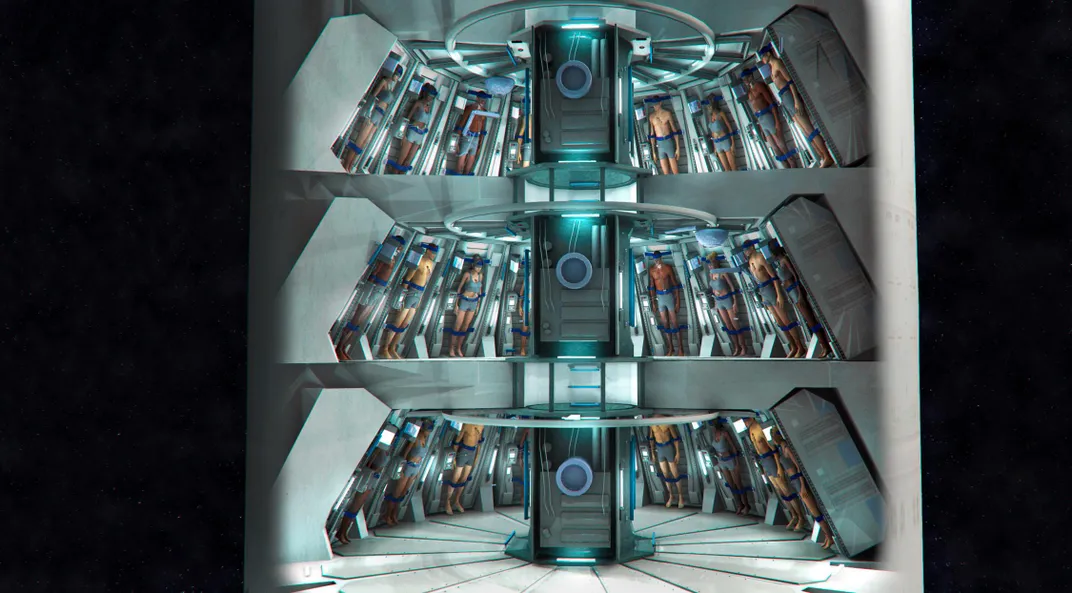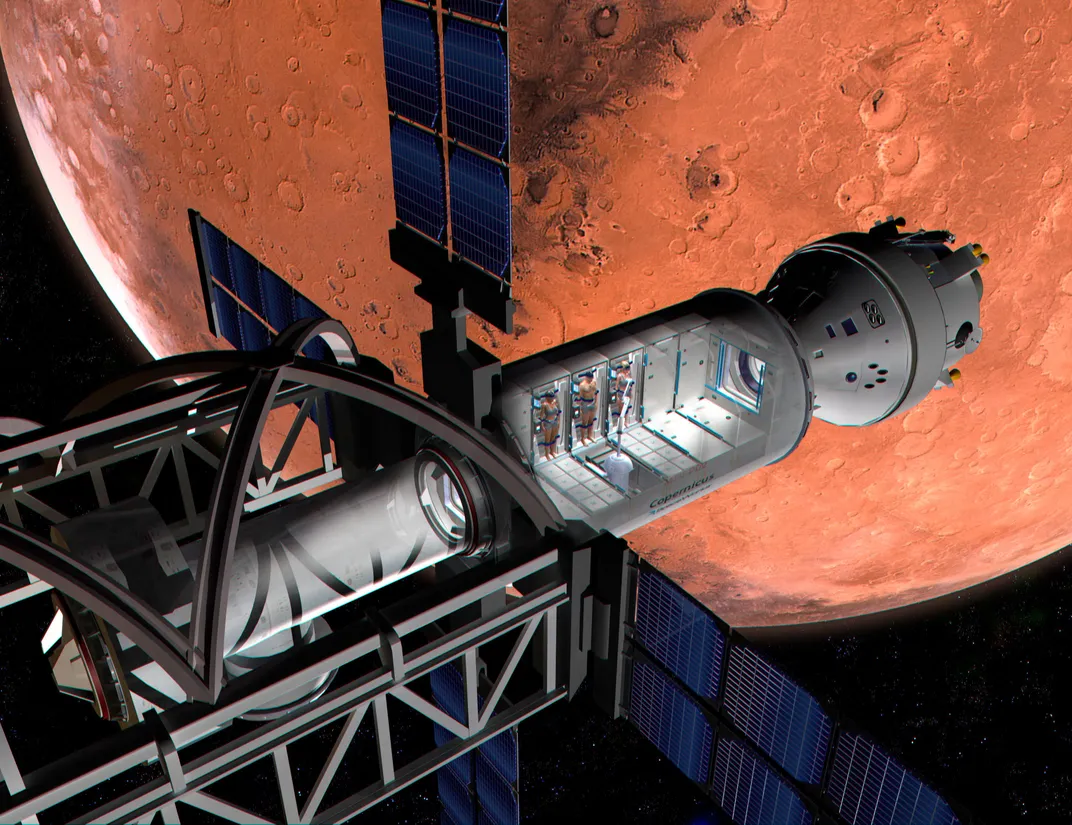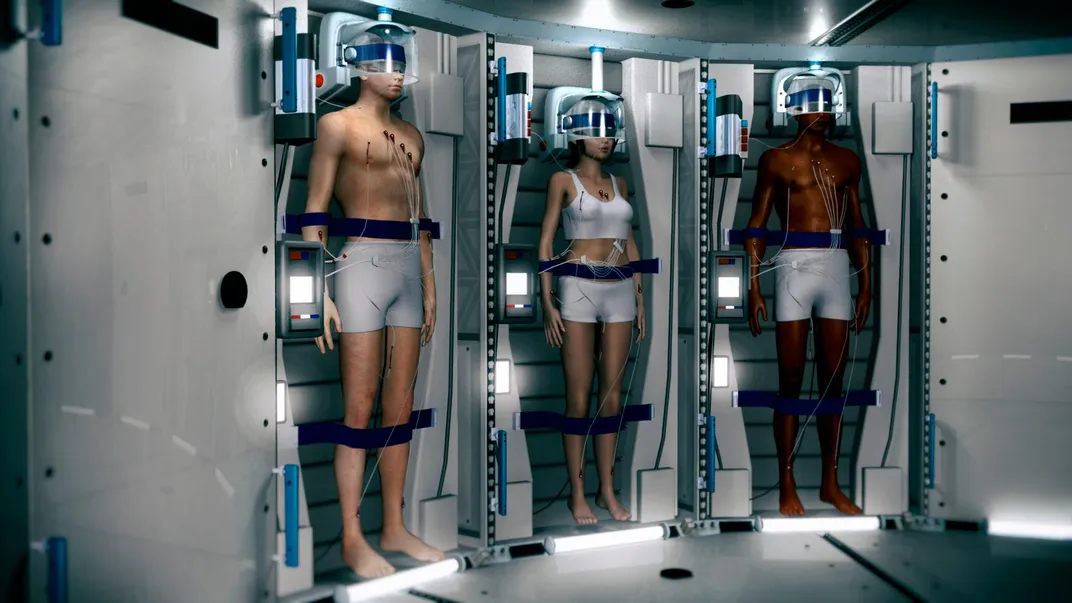Sleeping Their Way to Mars
For astronauts on long space voyages, the safest way to travel may be in induced hibernation.
/https://tf-cmsv2-smithsonianmag-media.s3.amazonaws.com/filer/00/ac/00acaa36-3745-43c0-82c2-b78b4b0002d0/14h_fm2017_opener_torpor-11_live.jpg)
Some day, astronauts packed into rocketing tin cans bound for other planets may be protected from radiation and space sickness by having their metabolisms depressed to a fraction of their typical rate. They’ll hibernate like bears as they hurtle through space for months at a time. Perhaps they’ll sleep in white coffin-like pods, as the cryo-preserved astronauts in futuristic fantasies like 2001: A Space Odyssey, Alien, and Avatar did.
More likely, though, astronauts and space colonists will learn a few tricks from dehydrated snails, which survive for a year or more ingesting nothing; giant pandas subsisting on low-calorie bamboo; leeches that survive a liquid nitrogen bath; children who have been submerged in frozen ponds yet can still be resuscitated; or skiers buried in an avalanche and brought back to life ever so slowly, reborn from a super-cooled, dreamless state.
Scientists call this phenomenon “torpor-induced hibernation.” Once considered outlandish, torpor induction—the old term was “suspended animation”—is under serious study for long-duration spaceflight.
This interest is due in part to advances in low-temperature surgery, but also to an increased understanding of cases like one documented in 1995 in the journal Prehospital and Disaster Medicine. A four-year-old boy fell through the ice of a frozen lake in Hanover, Germany. A rescue team pulled him out but could not resuscitate him in the field. His pupils were fixed and dilated, and he remained in cardiac arrest a full 88 minutes. Upon admission to the hospital, his core body temperature was 67.6 degrees Fahrenheit, a sign of severe hypothermia.
Twenty minutes later, as doctors worked to warm the boy’s chest cavity, the ventricles of his heart started contracting. Ten minutes after that, his heart resumed normal sinus rhythm. The boy made a full recovery and was discharged two weeks later. His doctors believed the icy lake had rapidly cooled his body to a state of protective metabolic torpor, preserving all vital organs and tissues while reducing the need for blood oxygen—in effect, saving the boy’s life. Cases like this are “exactly why we think that very deep hypothermia can allow our patients to survive,” writes Samuel Tisherman, Professor of Surgery at the University of Maryland School of Medicine, in an email. “The key is cooling the brain either before blood flow stops or as soon as possible after blood flow stops. The colder [it gets], the longer the brain can tolerate not having blood flow.”
Therapeutic hypothermia has become a part of surgical practice. Experimental procedures with cooling started as early as the 1960s, mostly in cardiac and neonatal cases. Babies were placed in cooling blankets or packed in ice and even snow banks to slow circulation and reduce oxygen requirements before heart surgery.
Today, physicians use moderate hypothermia (roughly 89 degrees) as a staple of care for some newborns in medical distress, such as those born premature or suffering from fetal oxygen deprivation (hypoxia). The babies are treated with cooling caps for 72 hours, which lower their metabolism just enough to reduce tissue oxygen requirements and allow the brain and other vital organs to recover.
By the same token, surgeons apply cooling and metabolic suppression to patients who’ve suffered various physical traumas: heart attack, stroke, gunshot wounds, profuse bleeding, or head injuries resulting in brain swelling. In emergency situations, anesthetists can insert a cannula—a slim tube—into the nose that feeds cooling nitrogen gas directly to the base of the brain. In one experimental therapy, surgeons insert a cardiopulmonary bypass cannula through the chest and into the aorta, or through the groin and into the femoral artery. Through these tubes, they infuse cold saline to reduce core body temperature and replace lost blood. Once the trauma surgeon has control of bleeding, a heart-lung machine restarts blood flow and the patient is given a blood transfusion.
“If you get cold fast enough before the heart stops, the vital organs, particularly the brain, can tolerate cold without blood flow for a time,” Tisherman explains. He is performing a clinical trial of this cold saline replacement technique in critically injured trauma victims in Baltimore, and he expects the study will last at least until the fall of 2018 and possibly later. The ensuing hypothermia rapidly decreases or stops blood flow for an hour or so, cutting oxygen requirements and giving surgeons time to repair critical wounds and then, ideally, warm the patient back to life.
The Torpor Enigma
Today, some in the aerospace community are looking to medically induced hypothermia and the resulting metabolic stasis as a way to save space and mass, along with freight, fuel, food, and frustration on the months-long flights to Mars or more distant planets. The studies are just beginning. One challenge is medical: What’s the best method for putting healthy astronauts into torpor? Even though therapeutic hypothermia is well understood in operating rooms, keeping people in deep space chilled and sedated for weeks, months, or years on end is an entirely unknown area of inquiry. Some scientists studying hibernation in animals suggest that other means of suppressing metabolism would be better: Specialized diet, low-frequency radiation, even the use of proteins that trigger hibernation in animals like bears and Arctic ground squirrels, which can regulate their metabolic rates safely and, in most cases, reversibly.
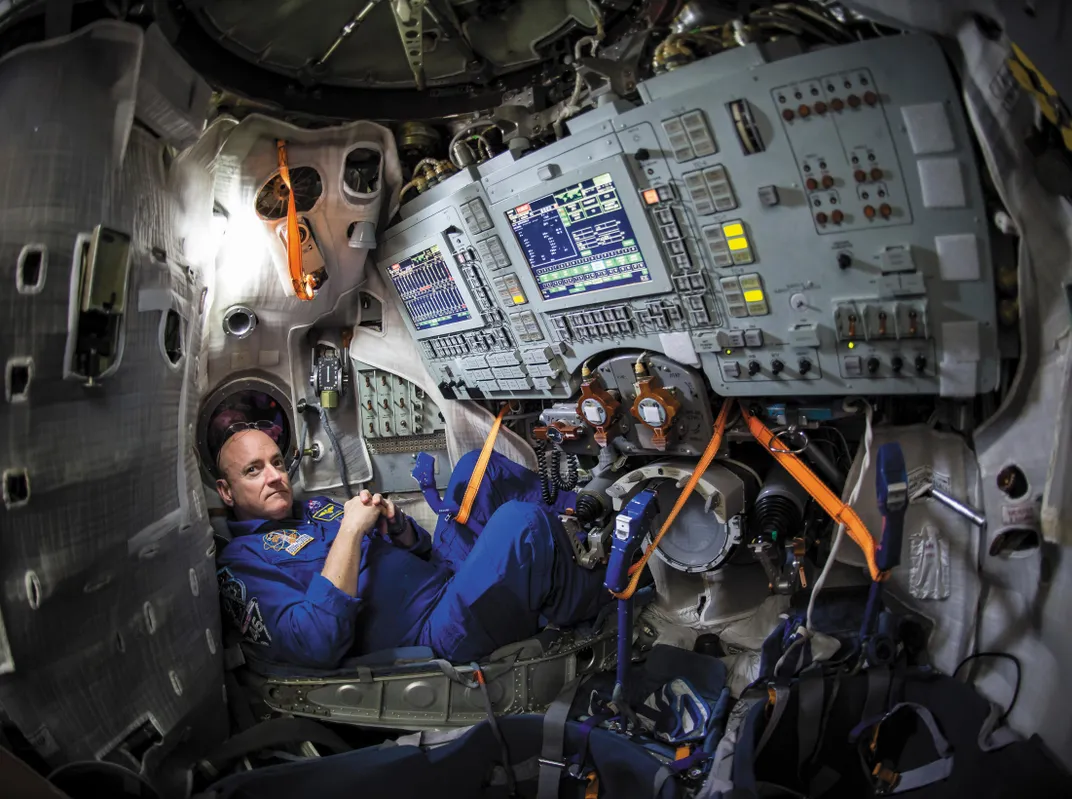
Another obvious hurdle is funding. How much will NASA prioritize research into metabolic stasis, both animal and human, when exploratory budgets are being reduced? Pete Worden, former director at NASA’s Ames Research Center in California and now the executive director of Breakthrough Starshot, says that with NASA’s emphasis on synthetic biology and the ability of organisms to survive and function in exotic environments like Mars, “it’s probably inevitable that the hibernation area is going to get funded.”
That optimism is hardly universal. “People are frustrated,” says Yuri Griko, a Moscow-trained NASA radiobiologist and lead senior scientist in Ames’ space biosciences division. “When Sputnik was put up in space in 1957, our generation was so excited, so inspired, and we believed that we’d be on Mars in the millennium. But…we’re still not on Mars. It’s personal for people like me because we expected to be much more progressed than we are right now.”
Griko acknowledges that metabolic suppression research is in limbo itself. He began at NASA in 2005 after spending five years at the biotech outfit Clearant, Inc., using ionizing radiation to inactivate pathogens in therapeutic blood products, transplant organs, and commercial biopharmaceuticals. NASA then invited Griko to research ways to protect astronauts from space radiation. It turns out that metabolic suppression is one of the most effective mechanisms nature provides.
When animals go into hibernation their bodies survive radiation without significant damage to their cells. Griko believes metabolic suppression mitigates radiation-induced damage by reducing biochemical processes and excessive oxidative stress. Hypoxia—lower oxygen consumption—is one possible explanation for the radio-protective effect: In hypoxia, production of oxygen free radicals and hydroxyl radicals is reduced. Because ionizing radiation releases free radicals causing cell damage, suppressing metabolism and oxygen consumption appears to do the reverse: it reduces normal cell death and prolongs healthy cell life.This protective effect is even more pronounced at lower temperatures.
Griko speculates that hibernation may also protect animals from the muscle atrophy and bone loss people typically experience in microgravity. Humans who eat a balanced diet while confined to bed rest for 90 days lose a little more than half of their muscle strength, Griko says. But bears that consume nothing and are confined to their dens for the same length of time or slightly longer lose only 25 percent of muscle strength and exhibit no signs of bone loss. He notes that animals capable of hibernation—tortoises and pocket mice—haven’t been flown in space in decades.
NASA did not fund his request for flight experiments involving hibernating animals. His current research is limited to surveys of existing hibernation studies, along with his own laboratory work on stasis in mice, leeches, and snails. Griko proposed a 2015 international conference on torpor that would have brought together the world’s hibernation experts to discuss deep-space applications. NASA declined to fund it, though Griko still hopes to raise the money.
“There are significant barriers to torpor research if we’re serious about going farther in space,” says Leroy Chiao, a former NASA astronaut and International Space Station commander who spent 193 days in orbit between October 2004 and April 2005. Animal research is a particularly sticky problem, one that has landed NASA in the crosshairs of animal-rights groups before. “Even research on simple primates starts getting people up in arms,” he says.
The Two-Planet Solution
Jason Derleth, a program executive with NASA Innovative Advanced Concepts in Washington, D.C., sees reason to hope. Under Derleth’s watch, NIAC has awarded two innovation grants since 2013, supporting one company’s detailed plans for torpor-enabled Mars transfer habitats. The project leader, SpaceWorks Enterprises, Inc., of Dunwoody, Georgia, about 20 miles north of Atlanta, is an aerospace design contractor for NASA and the Department of Defense and has done work in the development of tiny CubeSat satellite constellations. But it’s torpor that’s captured the imagination of SpaceWorks president and chief operating officer John Bradford.
“I’ve asked myself for 15 years how to engineer materials, structures, and propulsion systems to enable a mission to Mars and its moons,” he says. Bradford is a Ph.D. aerospace engineer who has led several NASA, Defense Advanced Research Projects Agency, and Air Force Research Laboratory projects designing military spaceplanes. He was also a consultant on the 2016 science fiction film Passengers, wherein Jennifer Lawrence and Chris Pratt played interplanetary settlers who wake from hibernation early. “We’re not in the vein of an Apollo mission anymore—no more ‘flags and footprints,’ ” he says. “We need to become a two-planet species.”
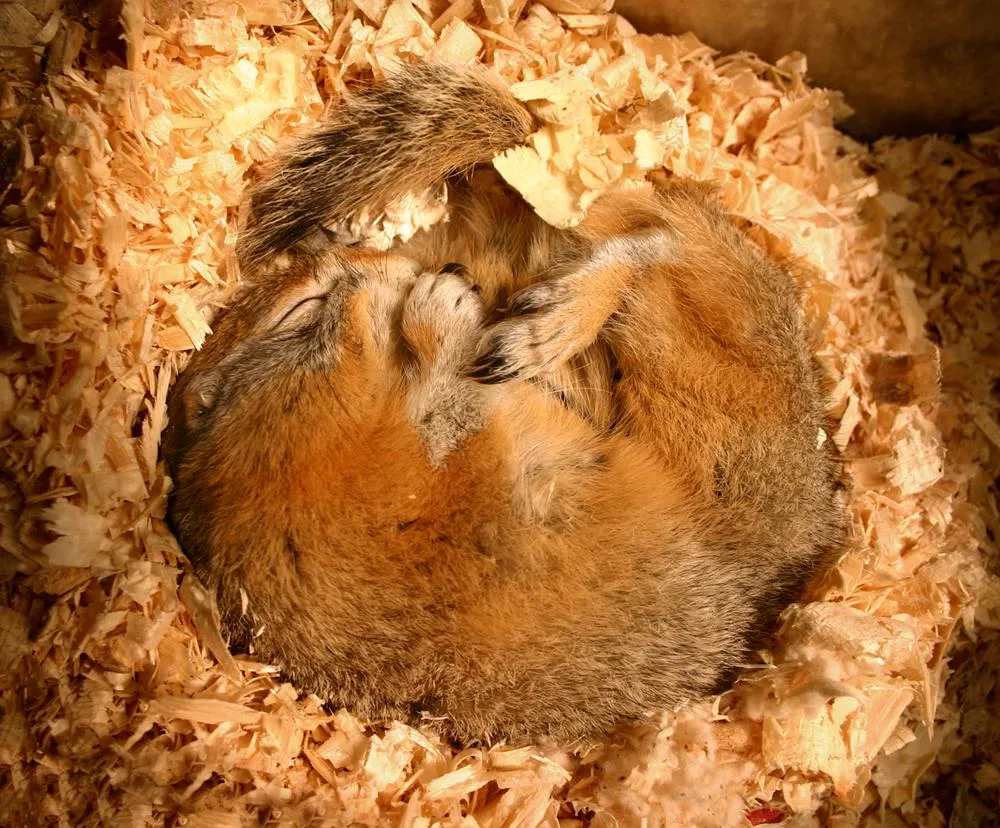
Bradford’s engineering and medical team used the first of those NIAC grants, issued in 2013, to design a compact zero-gravity, rigid-structure habitat based on the International Space Station crew module designs. The habitat featured closed-loop oxygen and water production systems, direct access to the Mars ascent and descent vehicles, and support for a crew of six, all of whom would be kept in torpor for the entire six- to nine-month Mars journey.
The proposed medical treatment relies on using techniques similar to the ones surgeons perfected to induce hypothermia. For example, cooling nitrogen gas could be fed to astronauts via nasal cannula, lowering brain and body temperatures to between 89 and 96 degrees—close enough to normal to maintain torpor without overcooling the heart or increasing the risk of other complications. Cooling tends to decrease the body’s ability to clot, Tisherman says. He has also noted that patients who are cooled to mild levels of hypothermia—93 degrees—for 48 hours or more have more infections than uncooled people.
In the SpaceWorks habitat, robotic arms in the module would be programmed to carry out routine chores, manipulate astronaut limbs, and check body sensors, urine evacuation lines, and chemical feeds. Robots would administer electrical stimuli to astronauts’ muscles to maintain tone, along with sedation to prevent a natural shivering response. The astronauts would also receive total parenteral nutrition, in which all nutrients—electrolytes, dextrose, lipids, vitamins, etc.—are administered via liquid through a catheter inserted in the chest or the thigh. SpaceWorks outfitted TPN supplies in the experimental module to last 180 days; should the habitat be required for a prolonged Martian stay, the module would have another 500 days’ worth of nutrition.
In all, the SpaceWorks Mars Transfer Habitat reduced total habitat mass, including consumables, to 19.9 tons (low-Earth-orbit weight). By comparison, NASA’s TransHab habitat, with consumables specified in the agency’s Mars Design Reference Architecture 5.0, weighs 41.9 tons. That’s a 52 percent decrease in mass. Compared with the NASA model, SpaceWorks was able to shrink total habitat consumables by 70 percent.
NIAC officials were intrigued. “SpaceWorks made an interesting proposal,” Derleth says. “People have been studying torpor for medical applications. But no one as far as we could find is actually doing an engineering study of what cryo-sleep or torpor would actually do to the architecture of a mission.”
In 2013 NIAC awarded SpaceWorks a Phase 1 grant of $100,000 to develop a rough torpor-enabled architecture for exploration-class missions—those with four to eight crew members heading to Mars or its moons. But the agency balked at the idea of putting all crew members in torpor for the entire journey. What about medical or spacecraft complications? How long could astronauts stay under without psychological or physical damage? What if some complication required their premature awakening? What about the slow waking and warming times to get the astronauts out of hibernation?
These questions sent the SpaceWorks team back to work. They designed a crew habitat for torpor that would keep at least a few astronauts awake on a rotating basis for piloting and interventions (as in the 1968 movie 2001, in which two crew members of the Jupiter-bound spacecraft Discovery remain awake while the others sleep).
Then Bradford’s team moved further. Designing three interconnected habitat modules for a 100-passenger “settlement class” Mars mission—colonists, in other words—the team produced a spacecraft and habitat that departed completely from anything in NASA’s plans. The SpaceWorks settlement-class craft includes two compact, rotating habitat modules, each accommodating 48 passengers in torpor. Rotation at varying speeds would produce artificial gravity to mitigate astronauts’ bone loss.
But in the bolder “sentry mode” proposal, a separate habitat module would accommodate four care-taking astronauts on duty throughout the mission. One or more could be rotated with others in torpor to keep crews fresh.
“You get 80 percent of the benefits by cycling through the hibernating crew and waking some up, rather than turning out the lights on everybody for six months,” Bradford says. Spacecraft accommodating settlers in torpor would be lighter, which would enable much greater velocities, shorter voyages, and, possibly, more efficient radiation shielding because of the radio-protective effect of metabolic stasis. Further, Bradford says, hibernating astronauts wouldn’t experience motion sickness, a common problem on the International Space Station.
Sleep Like a Bear
But what would torpor in space feel like? Not like being frozen dead in cryogenics, then being revived, according to Doug Talk, an obstetrician and SpaceWorks consultant who has used therapeutic hypothermia to treat oxygen-deprived babies. “[Cryogenics] has had zero success with that,” Talk says. “The human body isn’t meant to be frozen; it’s mostly water, and when water expands [as it does when it freezes], it produces cellular damage.”
More likely, astronaut torpor will be like coma, a state hovering between dreamless sleep and semi-conscious awareness. “Coma patients display cycles of brain activity that alternate between seeming wakefulness and non-REM sleep,” Talk explains. Even though coma patients are unable to move, their brains remain active and even responsive to outside stimuli, including verbal commands.
Bears experience hibernation in similar ways; their core temperature drops only a few degrees (similar to the mild-hypothermia temperature range in humans), while their metabolism drops 75 percent. Bears in northern climates can remain in torpor for seven to eight months without eating or drinking, and pregnant female bears will give birth to their young and nurse them even while in hibernation.
“Someone in torpor will act like the bear does,” Talk theorizes. “They’ll cycle through non-REM sleep and being awake. And like bears when they finally wake up, they’ll be sleep deprived.”
In May 2016, NIAC approved a second phase of the SpaceWorks project, this time releasing $250,000 to extend first-phase engineering, operational, and medical research plans. “Phase 1 projects have proven that what they’re talking about is real,” Derleth says. “We’re very happy to see Dr. Bradford’s progress.”
In addition to habitat engineering refinements, the SpaceWorks team initially proposed a two- to three-week hibernation test with a small number of healthy pigs. Pigs, like humans, are natural non-hibernators; therefore their physiological responses to torpor induction will offer better clues to what humans may expect than studies of mice or snails, obviously. Derleth says agency regulations prevented NASA from funding the pig study.
So SpaceWorks submitted an alternate proposal: to research existing metabolic suppression experiments comprehensively in order to establish a near-term road map for technology development, including more-methodical animal research leading to human trials. This summer, NIAC will conduct a mid-term review of SpaceWorks’ progress and determine whether to award them an additional $250,000.
“We continue to believe that live-subject research will be necessary to advance this torpor technology toward longer durations,” SpaceWorks founder and CEO John Olds wrote in a follow-up email. “That step may require private sponsors.”
Regardless of who pays for it, testing with animals can be difficult to do because it continues to raise ethical questions.
“I think NASA is right: Slow is the way to go,” says Arthur Caplan, director of the division of medical ethics at New York University Langone Medical Center. While there’s enthusiasm for suspended animation for long durations in space, NASA doesn’t need any more troubles from animal rights activists, in his opinion.
“Pigs are somewhat physiologically similar to humans, so pigs are a reasonable animal model for testing,” says Caplan. “Though it’s fair to say to critics: The number of pigs involved in this kind of study wouldn’t amount to one’s week’s breakfast for the average American.”
The Human Factor
Sci-fi movies and novels have romanticized torpor, Caplan says, suggesting humans could move in and out of that coma-like state without difficulty. That might not be the case.
The humans in which torpor will first be tested will be unusual people—most likely test pilots, Caplan predicts. “These people take risks every day; they understand the physiological risks because they test jets and know many colleagues who have died. I’ve had astronauts tell me they’ll enroll in any experiment just to get into space. Our job is to rein them in.”
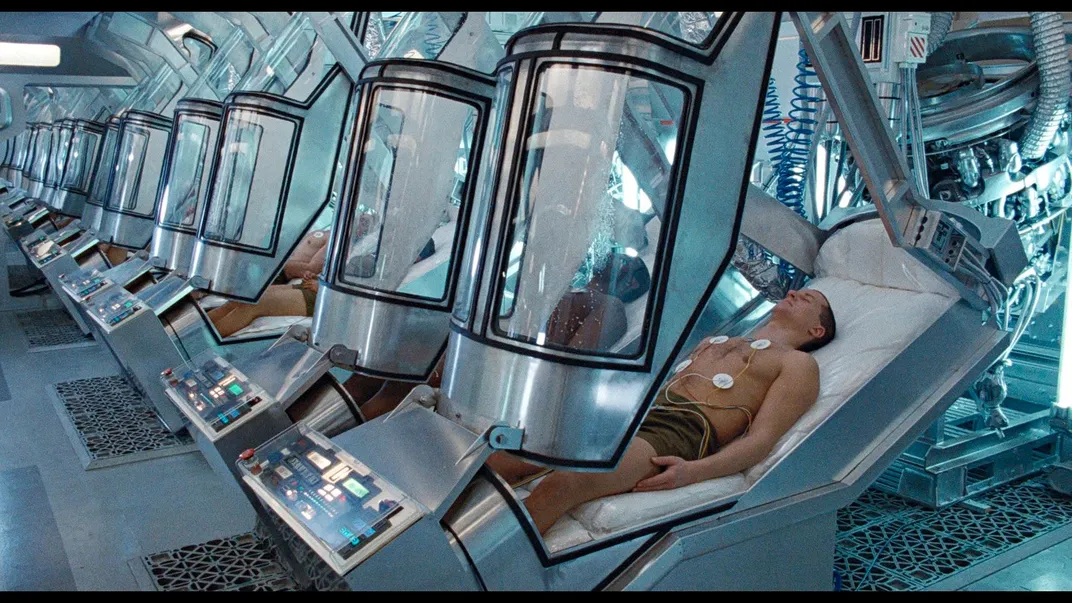
Human trials would be an unprecedented step. No one has ever tried to use hypothermia to suppress the metabolism of a person who wasn’t severely sick or injured, much less super-healthy astronauts.
“We’ve had lots of healthy people who have volunteered for long-term torpor experiments,” Talk says. “There’s a pent-up demand for people who want to punch out of life for six months. I’m sure the FDA wouldn’t approve of that.”
Meanwhile, Talk has invited two experts on therapeutic hypothermia—Alejandro Rabinstein, the medical director of the neuroscience intensive care unit at the Mayo Clinic, and Kelly Drew, a University of Alaska Fairbanks neuroscientist investigating animal hibernation—to join SpaceWorks’ research team. Drew and other scientists at the University of Alaska’s Institute of Arctic Biology are studying the hibernation patterns of endothermic animals like hedgehogs, Arctic ground squirrels, and bears. Their hope is to find the key to a healthy hibernation state—and the signaling cascade in the brain that induces it—that could be adapted to human astronauts without side effects.
The Arctic ground squirrel, for example, cools itself to 32 degrees Fahrenheit in winter. No scientist understands exactly what triggers its hibernation, although a particular brain and muscle receptor—the A1 adenosine receptor—appears to make the squirrel grow cold and sleepy, only to emerge with minimal bone and muscle loss eight months later.
“Adenosine is a neuromodulator that plays a role in sleep and in reducing brain excitability,” Drew says. “It’s ubiquitous in animal brains.” She has induced hibernation in Arctic ground squirrels by using a drug to stimulate their A1 adenosine receptors. Drew can also wake squirrels up from hibernation by using another drug to block the same receptor.
But the signaling cascade and genetic makeup of humans are far more complex and difficult to decipher. Adding to the complexity of the task is the fact that not all hibernators hibernate the same way.
The only primate known to do it, Madagascar’s fat-tailed dwarf lemur, spends seven months a year in torpor, mostly in hot weather; it survives by consuming fat stored in its tail. Low metabolic rates in animals do not require low body temperatures.
Meanwhile, Rabinstein, who plans to help SpaceWorks evaluate mild hypothermia to induce torpor, says the techniques that work in an ICU might not be so reliable in space.
“The fact that little children have ‘drowned’ and survived in ice ponds and lakes is remarkable and has given us hope,” he says. “But can we transform this [understanding of deep hypothermia] into a more mild degree of hypothermia and allow people to tolerate it for a longer period of time and get away with it, without psychological or physiological stress? We have to see, but we think there is a chance.”
